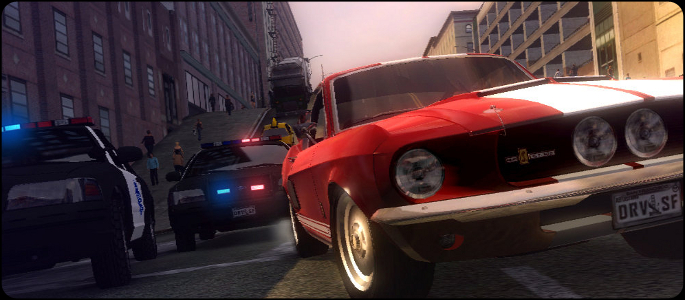The Driver series took a unique approach by trying to create the feel of police chases from movies, and added a unique mechanic of location based damage. Reflections Studios continued the mechanic through the series up until Driver: San Francisco which is taking a new approach to the formula. Find out of Driver: San Francisco is groovy or just plain god awful.
Surprisingly, the story is one of the strongest aspects of the game and builds to a satisfying climax. In most driving games, the story takes a backseat – pardon the pun – to the vehicular mayhem, but the story in Driver: San Francisco remains a dominant factor compelling the player throughout the game.
First of all, let me provide some background for the Driver series. The game leads off right where Driver 3 left off, but if you haven’t played a Driver game before, then don’t worry; the only thing you need to know is that Jericho is a bad guy and Tanner is a cop that doesn’t always follow the book. So, in Driver 2 Jericho served as a bodyguard for this guy called Solomon Caine. Jericho does the typical bad guy henchman stuff, but in Driver 3 Jericho kills Caine and takes over his empire. Jericho turns out to have a keen mind for crime and is a tough adversary for Tanner. The final scenes in Driver 3 have Jericho shooting Tanner in the back with a concealed gun. Driver: San Francisco starts six months after Driver 3 with Jericho is being escorted to a downtown prison in the back of a police van. With the help of a foreign sidekick, they are always foreign in the movies, and a paid off cop, Jericho is able to take control of the police van. Tanner and his partner Tobias Jones take pursuit, but Jericho gets the upper hand and rams their car into traffic. A large truck t-bones the car and knocks Tanner into a coma. End of story? No! Tanner is such a bad-ass that he can continue to solve crimes in his sleep.
While in the coma Tanner’s subconscious recreates the city exactly as it was when he got hit. So, when Tanner goes into his dream coma, Jones is freaking out about the accident and is saying that they need to chase after Jericho. As Tanner drives around, he will see billboards that say “wake up” and hear sounds of ambulances and doctors. When real life Tanner gets hit with a defibrillator, the dream world gets fuzzy and sometimes jerks the car. It is a really cool mechanic and as the player progresses through the story there will be more and more little hints and oddities from the real world. This mechanic also works its way into dialogue. Dream Tanner might hear the real Jones saying “we need you buddy,” and so dream Tanner says “what” to dream Jones, and dream Jones responds with, “I think that crash shook you up more than you think” or some other quip. There are a few funny conversations because of Tanner’s predicament, but there are much cooler aspects of the game.
The whole dream city aspect of the game is really compelling and manages to surprise the player in great ways. There are about 4 or 5 “dream levels” in the game. These are missions where some aspect of Tanner’s subconscious completely collapses in some way. For example, in one of the missions, all the cars in the city freeze and Tanner must chase an ambulance through a city of frozen cars. Another mission has Tanner driving down a completely empty city following clues. It is very cool to see Tanner acting out “physical” actions to try to come out of his coma. One of the best levels in the game is when Tanner is chasing dream Jericho down the freeway and Jericho is using his dream powers to throw cars at Tanner and the player has to dodge them while keeping up with Jericho. On top of that, Tanner decides to start throwing cars back because by this time he has realized he is in a coma. Driving down the freeway at 90 mph and throwing buses and station wagons while having to dodge cars at the same time is an incredibly fun mission and that single mission is better than most entire games.
So in the dream world, Tanner must complete missions to catch the dream Jericho and try to wake up out of the coma. Catching Jericho is a way for Tanner’s subconscious to try to bring him out of the coma, so as you get closer to catching dream Jericho, real life Tanner will twitch, shake his head, or show other signs of waking up. Since the player is in Tanner’s dreams, this gives the player the bonus of being able to do unrealistic things. The main “power” that Tanner gets is the shift ability. The shift ability lets Tanner possess anyone driver on the road. During most of the game, the player can switch between any vehicle on the road with just a tap of the X button. The camera will zoom out above the roads and the player can see the cars driving around the streets.As the game progresses, Tanner will unlock the ability to zoom further out to see more of the city. Shifting to other cars turns out to be a major part of the strategy. For example, if you are in a race, you can shift to a vehicle in oncoming traffic and use that car to cause a head on collision with your opponents. While you are shifting to a different car, the original car that you started the mission with will be driving on autopilot so you don’t have to worry about it crashing and losing you the race. The funny thing is that most cars have passengers and when you shift into the driver they will continue the conversation. If you shift into a car during a mission, Tanner will automatically say something like, “Hey, I just remembered we have to drive under a truck.” Now, shifting is fun and all, but if there aren’t any fun missions then the game will hold players’ interest for all of 5 minutes.
Luckily, the gameplay across missions varies a decent amount, certainly a lot more than previous titles in the series. There are missions where you have to take down criminals, missions where you are the criminals trying to escape, racing missions, protection missions, checkpoint races, and the usual “get to point B before your car breaks down” missions. The city mission contain all gameplay types and feature recurring characters. This allows the player the opportunity to see how these side characters develop throughout the game and to get some exposure to some side storylines. There is also enough variability between same mission types so that each one feels unique. Main story missions introduce new mission types at a regular pace, so that gameplay doesn’t get stale.
There are also smaller dare and stunt missions scattered throughout the city. These will have you do things like driving into oncoming traffic for a certain amount of time, drifting for a certain distance, jumping so many feet into the air and so on. These missions will give you willpower, which is the currency in the game. Willpower can be spent to unlock new cars and upgrades. There are over 100 licensed cars in the game from Ford to Maserati to Volkswagen, and they vary by three components: drift, speed, and strength. Also, the more cars the player owns the more their income is. Income is paid to the character every 20 minutes. For a lot of the side missions in the game, the player is free to choose whatever car they want to use. However, since the cars you unlock can only be used for side missions, not main story missions or city missions and, since the willpower is only useful for buying new cars and upgrades, then all the cars and the willpower system is a little useless. They feel like they are not being fully utilized. The only aspect that caries into the main missions are upgrades for your power meter. The power meter can be used for boosting and ramming other cars. The meter will recharge over time, which can also be upgraded. Lastly, there are special challenge missions that will let you upload your scores to leaderboards for competing and friends and others.
The game also has a great 70’s buddy cop movie aesthetic, much like the movie Starsky and Hutch or The Driver. The soundtrack is filled with 70’s funk and disco, and is great music to listen to as you race down the streets of San Francisco. Everything, and I mean everything on the streets can be smashed with your car. It doesn’t matter if its a 30 foot telephone pole or a bus stand, if your car hits it, then it’s flying to pieces. So, players don’t have to worry about being in a chase and coming to a complete stop due to some barely visible pole. The streets are also littered with car carrier trucks that can used as ramps. The driving itself is loose so that all the cars drift really easily. If you are the type of player that is used to a more tight and responsive driving mechanic than the driving will initially feel really slippery and out of control. In the beginning, you will be sliding all over the place and spinning out your tires as your opponents speed away from you. After a while, the driving becomes very fun and it is easy enough to learn the mechanics of how to drive.
On top of all the single player action, there is a robust multiplayer. There are a number of modes to choose from such as cops and robbers, straight up racing, a game of tag, and others. Depending on the game mode, the shift ability will either be available for use or not. For example, in the cops of robbers game mode, the player running away from the cops can’t use the shift ability but the cops chasing after him can. So, players who are controlling the cops can shift to get closer to their victim. As you play multiplayer and rank up, you will also unlock abilities to use in the multiplayer modes. The multiplayer is a great addition to the game.
Driver: San Francisco is a game that is full of surprises. Even when you know that the entire game takes place with Tanner in a coma, the game still manages to surprise you with how the story is handled. The driving mechanics which at first seem like they will be incredibly annoying turn out to be fun and thrilling. The shift ability plays a bigger role in strategy than initially thought and multiplayer contains old-fashioned game modes with a new twist.
PlayStation LifeStyle’s Final Score
+ Fun Singleplayer and Multiplayer – Some Mechanics Need More Work |
 |
–






